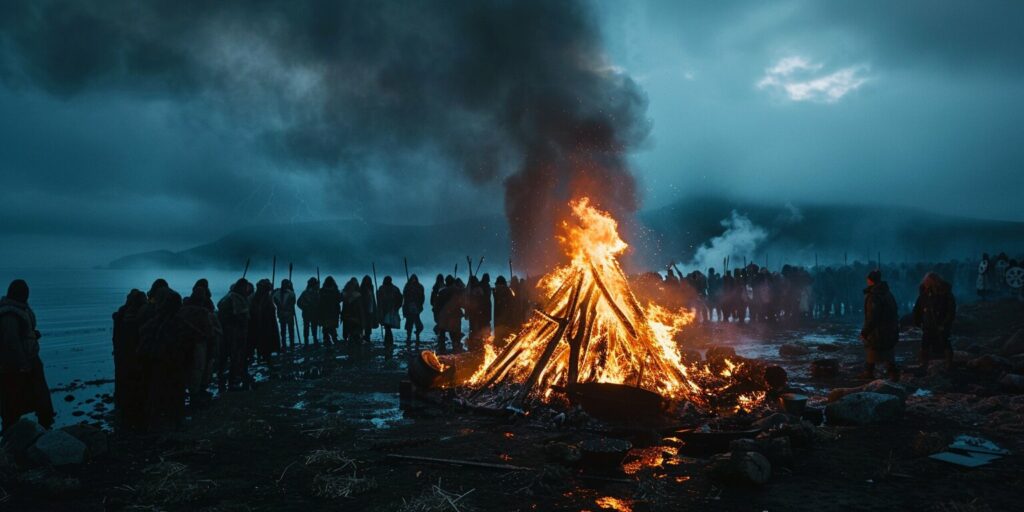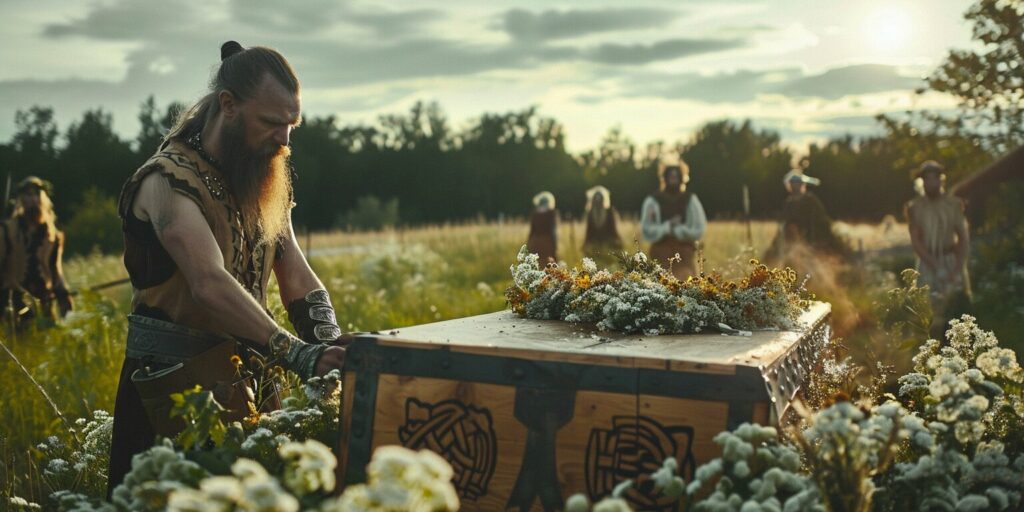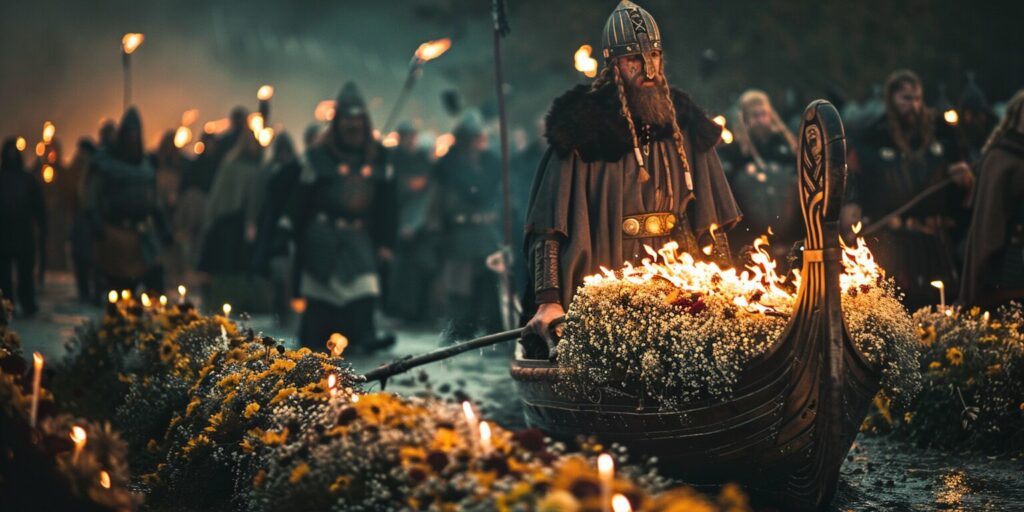Daily Life in the Viking Age, Viking Heritage, Vikings
Modern Tributes: The Legality of Viking Funerals Today
Viking burial practices have captured the imagination, with their fiery goodbyes on a longship reflecting ancient Norse beliefs about the afterlife. But are Viking funerals legal in the US? We examine the laws surrounding Viking funerals to see if they fit with modern times.
Is Having a Viking Funeral Legal?
Many people are curious about the legality of Viking funerals in the United States. If you are interested, knowing the laws in place is important. In this section, we will explore what it takes to have a Viking funeral in the US.
Viking Funeral Laws in the US
Laws regarding Viking funerals can vary by state in the US. The federal government does not have specific laws regarding this type of funeral. However, some states have their own rules about certain aspects of Viking funerals, including pyre ceremonies. Knowing your state’s laws is key to making sure your Viking funeral is legal.
Legal Requirements for a Viking-Style Funeral
You must take steps to plan a Viking-style funeral. These include getting necessary permits for the ceremony and ensuring your plans follow the law. Working with a funeral director who understands Viking traditions and the law is smart. They can help you do everything correctly.
Getting legal advice is vital if you’re thinking about a Viking funeral. By following the law and meeting all legal requirements, you can have a powerful funeral that honors the ancient Norse ways and is meaningful.
What Are the Different Ways to Conduct Viking Funerals?
Traditional Viking Burial Practices
Viking funerals reflect the Norse customs deeply. Open-air cremation is a well-known practice. It involves placing the deceased on a pyre and lighting it. This act symbolizes their journey to the afterlife. Mourners often accompany this ritual, chanting or saying prayers, whether at a funeral home or during a Viking-style ceremony on a longship.

Another custom is burial in mounds or barrows. These are large earthen structures. People would bury the dead with valuable items, or in the case of Viking tradition; they may want a Viking funeral that includes a longship. This practice ensured a rich next life for the deceased.
The Viking burial methods are meant to honor the dead. They focus on making the transition to the afterlife dignified, often in ways that could include the use of a casket or cremation.
Modern Interpretations of Viking Funerals
Today, Viking funerals have evolved. Many choose cremation to keep with tradition. The ashes are then scattered at sea, representing the deceased’s journey into the eternal waters.
People use Viking symbols and artifacts in modern Viking funerals, such as replica Viking ships or ceremonial weapons. These symbols stand for strength and remember Viking heritage, especially when a Viking-style funeral is wanted and legal in the United States.
Some even include Norse myths in their ceremonies. This might involve saying ancient texts. Or it can mean evoking the names of gods and goddesses. These actions deepen the connection to Viking tradition, particularly when elements like a longship and flame are legally incorporated into the ceremony.
Modern Viking funerals, albeit not always legal in the United States, give people a way to honor their Viking background. They mix old traditions with new ideas, making each funeral special and personal.
How Does a Viking Funeral Differ from Traditional Funerals?
Viking and traditional funerals are very different. They have separate rites, ceremonies, and cultural meanings. Knowing these differences is important to truly appreciate how special Viking funerals are. Let’s examine what happens during a Viking funeral and see how it differs from modern funerals.
Viking Funeral Rites and Ceremonies
Viking funerals honor Norse mythology and afterlife beliefs. The key part is placing the deceased on a ship filled with their belongings. This ship is then set on fire, showing their journey to the afterlife. The burning ship signifies a hopeful and grand afterlife, possibly joining ancestors in Valhalla.
They also include sending off the deceased with items like weapons, jewelry, and sometimes animals. These goods are meant to help the deceased in the afterlife. Choosing these objects was an essential part of the ritual.
Comparison of Viking Burials with Contemporary Funeral Services
Viking funerals stand out from modern ones because they celebrate life with flame and longship, offering a vivid example of ancient rituals. Traditional funerals are more about grief and respect for the dead. Vikings focus on honoring the person and their Norse roots.
Modern funerals often have a quiet, somber tone. Viking funerals are more about bidding farewell in a spirited way. They highlight adventure and the spirit of Viking culture.
Modern funerals follow certain cultural or religious traditions in a funeral home or other settings. Viking funerals, however, are a full cultural experience involving the legal use of a longship and flame in certain jurisdictions. They draw from ancient Norse customs, using special symbols and rituals, making a Viking funeral a unique goodbye.
Knowing about Viking funeral practices increases our respect for them. We see their special qualities when we compare them to today’s funerals. Viking funerals are full of unique, meaningful traditions that set them apart from the rest.
Can You Arrange a Legal Viking Funeral in the United States?
Arranging a Viking funeral in the United States has its challenges. While not common, they can be legal with expert help. It’s crucial to know what’s allowed and plan carefully for a special ceremony.

Legalities Surrounding Viking-Style Funerals in the US
Viking funerals face legal issues in the US. Laws change by state, so it’s important to research your area’s rules. Talking to local experts or lawyers is wise for understanding laws on permits and the special cremation process.
Due to safety concerns, not all parts of a Viking funeral are allowed. However, following local laws ensures that your ceremony is proper and honors tradition.
Consulting a Funeral Director for Viking Funeral Arrangements
Are you thinking about a Viking-style goodbye? A skilled funeral director is your go-to person. They know the legal side and can guide you through every step, including getting the right paperwork and finding ways to make the ceremony memorable yet legal.
Funeral directors ensure that your plans comply with the law and offer advice on unique ways to incorporate Viking customs into the service. With their help, you can have a ceremony that respects the law and celebrates your loved one’s life the Viking way.
What Are the Characteristics of a Genuine Viking Funeral?
A real Viking funeral has key elements that respect old Norse customs. These parts make the funeral true to Viking ways. We will look at using a Viking pyre, symbols, and beliefs to make a funeral authentic.
Elements of a Traditional Viking Funeral Pyre
The heart of a Viking funeral is the pyre. It’s made of special elements with deep meanings. For example, wood, like oak, stands for the link between the earth and the spirit world. People also add herbs and spices to make the pyre more ceremonial.
The pyre is built to look like a ship, showcasing the journey to the afterlife. This ship-shape ties the living with the spiritual world.
The body is placed on the pyre, along with personal items. This shows deep respect for the departed and their life.
Incorporating Viking Symbols and Beliefs in the Funeral Process
Aside from the pyre, Viking symbols and beliefs are key to the funeral. They have been part of Viking culture for a long time.

One such symbol is the Valknut, tied to Valhalla and Odin. It shows the unbreakable link between the dead and their destiny.
Mjolnir, Thor’s hammer, is another important symbol. It means protection and points to a safe afterlife.
Believing in life after death is very Viking. Ceremonies and prayers show respect while recalling life’s circle.
Following these Viking practices makes a funeral truly special. It ensures the legacy of the loved one is honored in a significant way.
Why Do Some Individuals Desire Viking Funerals?
Viking funerals attract some people because of their deep history, symbolic meaning, and connection to their ancestors. Many find the ancient Norse traditions appealing and want to pay tribute to their Viking forebears. This kind of send-off is seen as adventurous and memorable.
The Appeal of a Viking-Style Funeral for Certain Individuals
A Viking-style funeral links people to historic Norse practices and beliefs. It’s a way to show respect for Viking roots, touching on adventure and the spirit of the past. The fiery conclusion of a Viking funeral often strikes a chord with those looking for a unique way to say goodbye.
Viking funerals stand out from typical services, letting people honor loved ones in their own way. This shifts away from common funeral customs, letting individuality and personal values shine. It’s a chance for people to craft a memorial service that truly reflects who they are.
Exploring the Notable Aspects of a Viking Funeral
Using fire in a Viking funeral serves a special purpose, signifying a journey to the afterlife. It represents the belief in a rewarding and bold life after death. This aspect makes the ceremony both symbolic and grand.
Adding Viking symbols and rituals enhances the experience, making it feel genuine and deeply linked to Viking heritage. Items like ships, axes, runes, and traditional poems and songs offer a rich connection to ancient Norse culture.
Another focus is on celebrating life surrounded by loved ones. The event becomes a tribute to achievements rather than simply a moment of parting. The gathering reminds everyone of the departed’s positive impact during their life.
In summary, a Viking-style funeral offers a special way to honor loved ones, combining unique aspects that cherish both the deceased and the Norse cultural legacy. It allows for a personalized ceremony that deeply reflects the ties to Viking history and tradition.
Summary
We explored Viking burial practices and why are Viking funerals illegal in today’s world. While some desire a Viking-style send-off, it’s crucial to understand what is legal in the US regarding such ceremonies. First, we looked at laws and rules, especially in the United States. It’s key to remember that Viking funerals, although uncommon, can happen with the help of a skilled professional.
Viking burials can happen in many ways. These include traditional methods like open-air cremation or burial in mounds. There are also newer ways that feel connected to Viking traditions. This allows for a special way to remember a person’s Viking past.
Many people find Viking funerals appealing because of their history and connections to their past. By understanding and respecting what a real Viking burial stands for, people can honor their Viking background, making it a very heartfelt way to remember someone.

